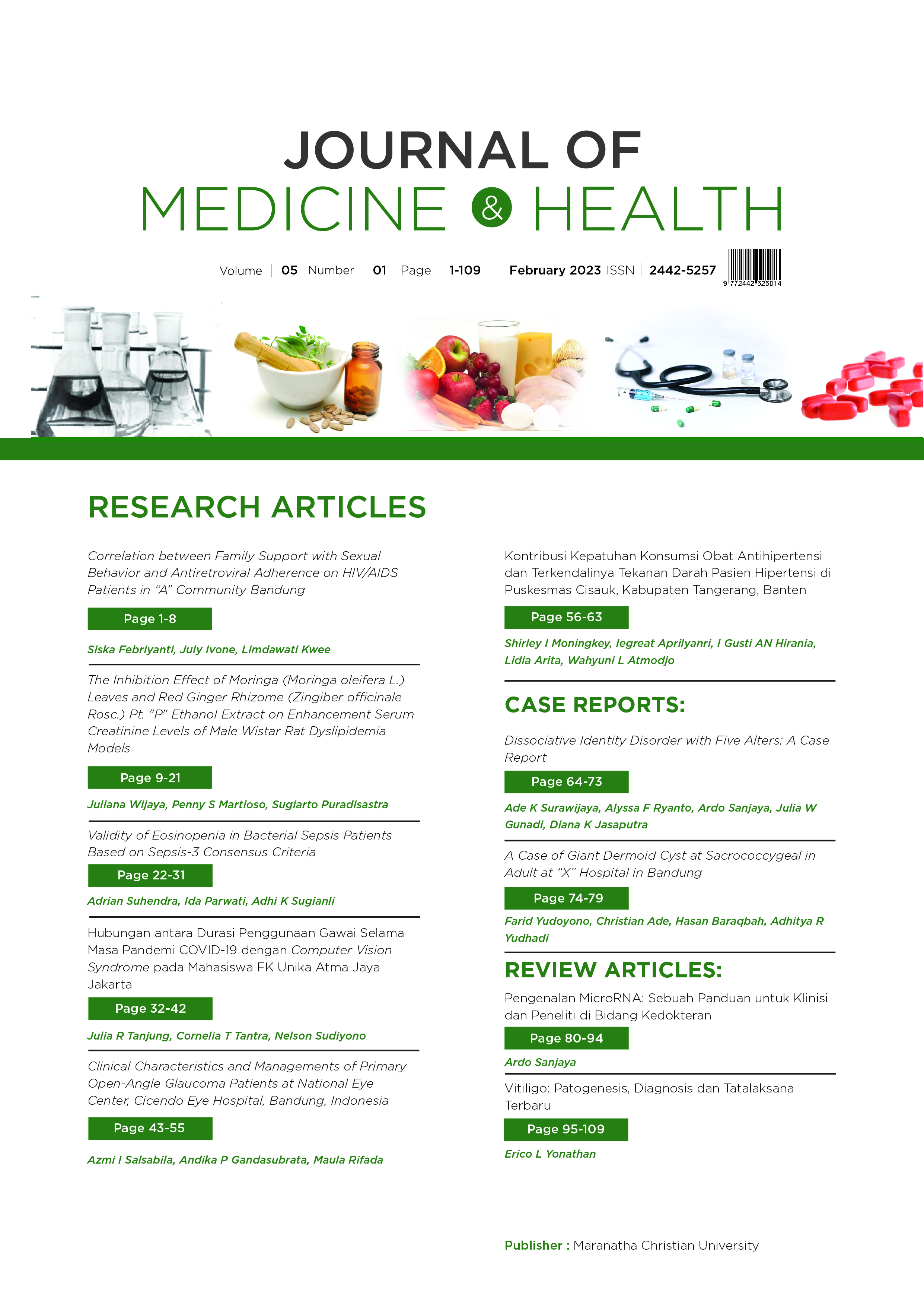Correlation between Family Support with Sexual Behavior and Antiretroviral Adherence on HIV/AIDS Patients in “A” Community Bandung
DOI:
https://doi.org/10.28932/jmh.v5i1.3398Keywords:
adherence, family support, HIV, sexual behaviorAbstract
Family support is the attitude, action, and acceptance of the family towards its members. One of the functions of the family is to support the health care of other family members. HIV (Human Immunodeficiency Virus) is a retrovirus that attacks the immune system of CD4+ cells, and if not treated immediately, the patient will fall into an AIDS (Acquired Immunodeficiency Syndrome) condition. HIV/AIDS patients need support from both social and family. The incidence of HIV/AIDS in West Java during 2019 was ranked third in Indonesia, which was 6,066 patients. The aim of this study was to determine the relationship between family support with patient’s sexual behavior and adherence to taking antiretroviral drugs. The research method used is an analytical method with a cross-sectional design. The sample of this study was HIV patients who are members of Community "A" Bandung, with a total of 51 respondents. Statistical analysis showed that there was a correlation between family support and sexual behavior of HIV/AIDS patients (p=0.013), however, there was no correlation between family support and antiretroviral adherence (p= 0.12). In conclusion, family support is related to sexual behavior, but not related to adherence to taking antiretrovirals in HIV/AIDS patients.Downloads
References
Departemen Kesehatan Republik Indonesia. Pedoman Pelaksanaan Pencegahan Penularan HIV dan Sifilis dari Ibu ke Anak Bagi Tenaga Kesehatan.2015. Diunduh 28 Agustus 2019. Tersedia dari: http://siha.depkes.go.id/portal/files_upload/Manlak_PPIA_2015.pdf
World Health Organization. HIV/AIDS. 2019. Diunduh 29 Agustus 2019. Tersedia dari: https://www.who.int/news-room/fact-sheets/detail/hiv-aids
Kementerian Kesehatan Republik Indonesia. Hari AIDS Sedunia. 2018. Diunduh 1 Januari 2020. Tersedia dari: http://www.depkes.go.id/article/view/18120300001/hari-aids-sedunia-momen-stop-penularan-hiv-saya-berani-saya-sehat-.html
Kementerian Kesehatan Republik Indonesia. Infodatin HIV 2020. Diunduh 4 Januari 2021. Tersedia dari: https://pusdatin.kemkes.go.id/article/view/20111200002/infodatin-hiv.html
UNAIDS. HIV and AIDS Estimates. Diunduh 9 Mei 2020. Tersedia dari : https://www.unaids.org/en/regionscountries/countries/indonesia
Lia D. Perilaku Seksual pada Remaja Perempuan. 2017. Purwokerto: Fakultas Psikologi Universitas Muhammadiyah Purwokerto. Diunduh 29 Juli 2019. Tersedia dari : http://repository.ump.ac.id/3795/3/Bab Ii_Dwi Retno April Lia_Psikologi%2717.Pdf
Burnham KE, Cruess DG, Kalichman MO, Grebler T, Chauncey C, Kalichman SC. Trauma symptoms, internalized stigma, social support, and sexual risk behavior among HIV positive gay and bisexual MSM who have sought sex partners online. 2015. Diunduh 7 Agustus 2019 Tersedia dari : https://www.tandfonline.com/doi/abs/10.1080/09540121.2015.1096894
Poudel KC, Buchanan DR, Amiya RM, Kalpana TP. Perceived Family Support and Antiretroviral Adherence in HIV-Positive Individuals: Results from a Community-Based Positive Living with HIV Study. 2015; 1(36): 71–91.
Ismayilova L, Sewamala FM, Karimli L. Family support as a mediator of change in sexual risk-taking attitudes among orphaned adolescents in rural Uganda. J adolesc health. 2012; 50(3):228-35.
Marubenny S, Aisah SM. Perbedaan Respon Sosial Penderita HIV-AIDS yang Mendapat Dukungan Keluarga dan Tidak Mendapat Dukungan Keluarga di Balai Kesehatan Paru Masyarakat (BKPM) Semarang. J Keperawatan Kom. 2013;1 (1): 43-51.
Justiz Vaillant, Angel A, Peter G. Gulick. HIV Disease Current Practice. StatPearls, StatPearls Publishing, 20 September 2022.
Brew BJ, Garber YJ. Neurologic sequelae of primary HIV infection. 2018. Diunduh 3 September 2020. Tersedia dari: https://pubmed.ncbi.nlm.nih.gov/29604985/
HIV National Institute of Health. HIV Prevention. Diunduh 5 April 2020. 2020. Tersedia dari : https://hivinfo.nih.gov/understanding-hiv/fact-sheets/basics-hiv-prevention
HIV National Institute of Health. When to Start HIV Medicines.2020. Diunduh 27 Juni 2020. Tersedia dari : https://hivinfo.nih.gov/understanding-hiv/fact-sheets/when-start-hiv-medicines
Chiampas TD. HIV Treatments: List of Prescription Medications.2020. Diunduh 9 Desember 2020.Tersedia dari : https://www.healthline.com/health/hiv-aids/medications-list
Nurihwani. Hubungan Dukungan Keluarga terhadap Kepatuhan Pengobatan Antiretroviral (ARV) pada Orang dengan HIV dan AIDS (ODHA) di Puskesmas Jumpandang Baru. 2017. Diunduh 4 Juni 2020. Tersedia dari : http://repositori.uin-alauddin.ac.id/8103/1/NURIHWANI.pdf
Abidin AA. Perilaku Penyimpangan Seksual dan Upaya Pencegahannya di Kabupaten Jombang. 2017;1, 547.
Pasaribu HS & Sodik MA. Pengaruh Perilaku Seksual Beresiko terhadap Kejadian HIV / AIDS.2018. Diunduh 29 Agustus 2019.Tersedia dari : https://osf.io/k9xsg/download/?format=pdf
Gilroy SA. HIV Infection and AIDS Workup.2020. Diunduh 11 Oktober 2020. Tersedia dari : https://emedicine.medscape.com/article/211316-workup#c1
Calles NR, Evan D, Terlonge D. Pathophysiology of the Human Immunodeficiency Virus. HIV curriculum for the health professional. 2010: 7-14. Diunduh 3 Januari 2023. Tersedia dari :https://bipai.org/sites/bipai/files/2-Pathophysiology-of-HIV.pdf
Downloads
Published
How to Cite
Issue
Section
License
Copyright (c) 2023 Siska Febriyanti, July Ivone, Limdawati Kwee

This work is licensed under a Creative Commons Attribution-NonCommercial 4.0 International License.
Authors who publish with this journal agree to the following terms:
- Authors retain the copyright and grant the journal right of first publication with the work
simultaneously licensed under a Creative Commons Attribution-NonCommercial 4.0 International License that allows others to share the work with an acknowledgement of the work's authorship and initial publication in this journal. - Authors are able to enter into separate, additional contractual arrangements for the nonexclusive distribution of the journal's published version of the work (e.g., post it to an institutional repository or publish it in a book), with an acknowledgement of its initial publication in this journal.
 This work is licensed under a Creative Commons Attribution-NonCommercial 4.0 International License.
This work is licensed under a Creative Commons Attribution-NonCommercial 4.0 International License.

















